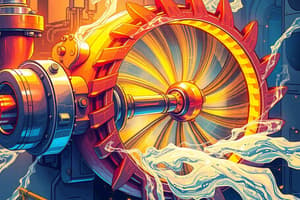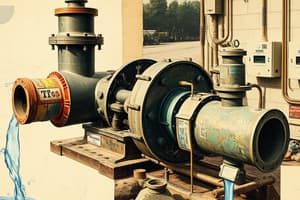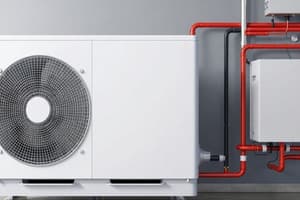Podcast
Questions and Answers
How does the head added by a centrifugal pump change with an increase in flow rate, assuming a constant impeller diameter and speed?
How does the head added by a centrifugal pump change with an increase in flow rate, assuming a constant impeller diameter and speed?
- It increases linearly.
- It decreases. (correct)
- It remains constant.
- It increases exponentially.
What is the common practice when analyzing the operating characteristics of a pump in relation to its flow rate?
What is the common practice when analyzing the operating characteristics of a pump in relation to its flow rate?
- Isolating each characteristic for individual analysis.
- Calculating the correlation coefficient between each characteristic.
- Focusing solely on the head versus flow rate relationship.
- Plotting all characteristics together on a single graph. (correct)
If a pump's performance curve shows a steep decline in head as flow rate increases, what can be inferred about the pump's operation?
If a pump's performance curve shows a steep decline in head as flow rate increases, what can be inferred about the pump's operation?
- The pump's performance is highly sensitive to changes in flow rate. (correct)
- The pump requires a larger impeller.
- The pump is operating at optimal efficiency.
- The pump is likely experiencing cavitation.
What does the intersection of the pump characteristic curve and the system curve represent?
What does the intersection of the pump characteristic curve and the system curve represent?
According to pump affinity laws, what is the relationship between pump flow rate (Q) and pump speed (N)?
According to pump affinity laws, what is the relationship between pump flow rate (Q) and pump speed (N)?
Based on the affinity laws, how does changing the speed of a pump affect the brake horsepower (BHP)?
Based on the affinity laws, how does changing the speed of a pump affect the brake horsepower (BHP)?
What does the system curve represent in a pumping system?
What does the system curve represent in a pumping system?
How does a static head in a system affect the system performance curve?
How does a static head in a system affect the system performance curve?
Why should a throttling valve not be placed on the intake line of a pump?
Why should a throttling valve not be placed on the intake line of a pump?
In systems where the static head varies (e.g., draining a tank), how is the system head typically defined?
In systems where the static head varies (e.g., draining a tank), how is the system head typically defined?
What is the effect of increasing the impeller diameter on the pump performance curve, assuming all other factors remain constant?
What is the effect of increasing the impeller diameter on the pump performance curve, assuming all other factors remain constant?
How is total head calculated in a pumping system?
How is total head calculated in a pumping system?
If a centrifugal pump is operating at a fixed speed and impeller diameter, and the system head increases, what is the likely effect on the flow rate?
If a centrifugal pump is operating at a fixed speed and impeller diameter, and the system head increases, what is the likely effect on the flow rate?
What is the significance of efficiency lines on a pump performance curve?
What is the significance of efficiency lines on a pump performance curve?
In a pumping system, what does a steeper system curve indicate?
In a pumping system, what does a steeper system curve indicate?
How does the Net Positive Suction Head Required (NPSHR) impact the design and operation of a pumping system?
How does the Net Positive Suction Head Required (NPSHR) impact the design and operation of a pumping system?
If a pump is required to deliver a higher flow rate than its current operating point allows, what adjustment might be made (assuming the system allows)?
If a pump is required to deliver a higher flow rate than its current operating point allows, what adjustment might be made (assuming the system allows)?
In the context of pump performance, what does 'affinity' refer to?
In the context of pump performance, what does 'affinity' refer to?
For a centrifugal pump operating at a constant speed, what happens to the required Brake Horsepower (BHP) as the flow rate is reduced towards the shut-off head?
For a centrifugal pump operating at a constant speed, what happens to the required Brake Horsepower (BHP) as the flow rate is reduced towards the shut-off head?
How does the shape of the pump performance curve (Head vs. Flow) typically change as the fluid viscosity increases?
How does the shape of the pump performance curve (Head vs. Flow) typically change as the fluid viscosity increases?
Flashcards
Pump Head vs. Flow Rate
Pump Head vs. Flow Rate
At constant speed, for a given impeller diameter, increased flow rate decreases the head added by a centrifugal pump.
Pump Performance Curve
Pump Performance Curve
A graphical representation of a pump's head (H), efficiency (η), brake horsepower (BHP), and Net Positive Suction Head Required (NPSHR) against flow rate (Q).
Operating Point
Operating Point
The intersection of the pump's characteristic curve and the system curve.
Moving Operating Point
Moving Operating Point
Signup and view all the flashcards
Total Head
Total Head
Signup and view all the flashcards
Static Suction Lift
Static Suction Lift
Signup and view all the flashcards
Net Positive Suction Head Required (NPSHR)
Net Positive Suction Head Required (NPSHR)
Signup and view all the flashcards
Pump Affinity Laws
Pump Affinity Laws
Signup and view all the flashcards
System Curve
System Curve
Signup and view all the flashcards
Study Notes
Pump Performance Curves
- For a given impeller diameter and constant speed, the head added by a centrifugal pump decreases as the flow rate increases.
- Other operating characteristics also vary with the flow rate.
- It's common practice to plot all characteristics together on a single graph.
- A pump performance curve is illustrated, showing the relationship between head (H), flow rate (Q), brake horsepower (bhp), and net positive suction head required (NPSHR).
Head vs. Flow Rate
- The graph typically shows head (H) on the y-axis and flow quantity (Q) on the x-axis.
Pump Performance Curves Characteristics
- A performance curve can display pump characteristic curves, efficiency lines, and horsepower (hp) curves.
- Curves can show different performance characteristics, such as curves for different speeds (e.g., 3450 rpm, 2880 rpm, 1750 rpm).
- Curves can show different impeller sizes (e.g., 5 in impeller, 4½ in impeller).
Example
- A pump is required to pump 500 gpm at 425 feet total head, and the performance curve for 1750 rpm is known.
- The goal is to determine the speed required to achieve the desired performance without changing the efficiency or impeller size.
Solution for Example
- From affinity equations for H and Q, the quantity (H/Q²) is constant for a pump with a given impeller size.
- To apply an affinity equation, it is necessary to know the operating point on the 1750 rpm curve.
- Find the operating point, choosing random values of Q and solve for H such that (H/Q²) = 1.7 EE - 3.
- These four points are plotted on the performance curve graph.
- The intersection of the constant efficiency line and the original 1750 rpm curve is at 440 gpm.
Pump Affinity Laws for Speed Change
- Q₁/Q₂ = N₁/N₂: Relationship between flow rates (Q) and speeds (N).
- H₁/H₂ = (N₁/N₂)²: Relationship between heads (H) and speeds (N).
- BHP₁/BHP₂ = (N₁/N₂)^3: Relationship between brake horsepower (BHP) and speeds (N).
System Curves
- A system curve graph can be made from the resistance to flow of the piping system.
- This resistance varies with the square of the flow rate since hf varies with V² in the Darcy friction formula.
- H₁/Q₁² = H₂/Q₂² represents the relationship between head (H) and flow rate (Q) in a system.
Terms Used in Pumping Stations
- Velocity Head measures the kinetic energy of the flow.
- Friction Head represents the head loss due to friction in the pipes.
- Total Head is the total energy that the pump has to add to the fluid.
- Static Discharge Head is the vertical distance from the pump to the discharge point.
- Total Static Head is the total vertical distance the pump has to lift the fluid.
- Static Suction Lift is the vertical distance from the pump to the suction fluid level when the pump is above the fluid source.
- Pump is the machine used to move the fluid.
Static Head Effect on System Curves
- When a static head (hst) exists in a system, the loss curve is displaced upward an amount equal to the static head.
Operating Point
- The intersection of the pump characteristic curve with the system curve defines the operating point
Moving the Operating Point
- After a pump is installed, it may be desired to vary the pump's performance.
- Placing a valve in the discharge line, the operating point can be moved along the performance curve by opening or closing the valve.
- A throttling valve should never be placed in the intake line since that would reduce NPSHA.
- In most systems, the static head varies as the feed tank is drained or as the discharge tank fills.
- The system head is then defined by a pair of parallel curves intersecting the performance curve.
- The two intercept points represent the maximum and minimum capacity requirements.
Studying That Suits You
Use AI to generate personalized quizzes and flashcards to suit your learning preferences.




